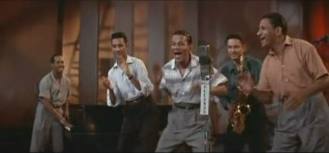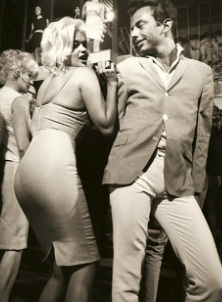The Girl Can't Help It Dir: Frank Tashlin (1956)
"...still the great music film....I still love that film." - Paul McCartney
"the only truly great rock 'n' roll film" - Martin Scorsese
Posters emphasised Jayne Mansfield's body & movie's black musical artists. Note - poster top right gives white performers top billing.
So successful was Rock Around the Clock that Hollywood immediately produced several blatant rip-offs, including Sam Katzman's Don't Knock the Rock. The most significant of these was The Girl Can't Help It. Although this movie, like the others, aimed at exploiting the rock 'n' roll phenomenon, Girl had important differences. It was made in color, by a major studio, with expensive sets and used the expensive new widescreen Cinemascope process. It had a couple of well-known stars of the fifties such as comedian Tom Ewell, and boasted the physical attributes of Jayne Mansfield, a Marilyn Monroe clone who was a much better comedienne than Monroe ever was. And the movie was directed by Frank Tashlin, admired in both Hollywood and France for his offbeat and innovative approach to film comedy.Tashlin had no intention of making a condescending tribute to rock 'n' roll. Nor was he interested in juvenile delinquency, the topic that up to now had always been linked to movies about rock 'n' roll. Instead, he satirized the show biz hype surrounding rock 'n' roll's performers, audiences and those looking to make money out of the phenomenon.
Paul McCartney has provided one of the best verdicts on the movie's musical significance:
"The Girl Can't Help It is still the great music film. They had only treated [rock 'n' roll] music films as B pictures up till then or used [rock 'n' roll] music just as a theme tune as in Blackboard Jungle. Or those little black and white productions with an Alan Freed as the personality, and lots of what they thought of were 'black acts'....We idolised these people and we always thought they were given crummy treatment - until The Girl Can't Help It."
The Girl Can't Help It was also intended to attract not just teenagers; it assumed that older audiences would be receptive to the movie's music as well as to its satirical attitude towards on the musical industry.In this movie, rock 'n' roll was accepted as a new genre within American cinema musicals. It took its place alongside another genres featured in the movie: rhythm and blues, swing, torch, jazz blues. Tashlin also incorporated the sexual suggestiveness of rock 'n' roll to augment the movie's considerable verbal and visual innuendo. He combined this raucous and sexualized aspect of the music with a satire on another cultural phenomenon of the 1950s: Marilyn Monroe.Whereas Rock Around the Clock and other Alan Freed movies aimed to reassure the older generation that rock 'n' roll was harmless good fun, The Girl Can't Help It emphasized its exual element and suggestive energy. It also made clear that rock 'n'roll was a commercial product, ripe for exploitation by shrewd bisinessmen. It was a new form of show business. It didn't hurt that the movie came out just as the 'payola' scandal was beginning to emerge, with accusations that disk jockeys like Alan Freed accepted bribes from record companies to play certain records.
Rock Around the Clock and Don't Knock the Rock had quickly established rock 'n' roll's appeal to a surprisingly wide audience, one not confined to teenagers. The Girl Can't Help It continued this process in a much more sophisticated process, both cinematically and musically. Its daring approach aimed to appeal to teenagers and an older generation while at the same time mocking the attitudes and enthusiasms of both generations. Although the director was years older than the (mainly) teenage performers in the movie, he presents their performances with the respect, skill and ingenuity usually given to filmed versions of Broadway musicals. Instead of belittling Little Richard or Fats Domino with clumsy editing and shoddy lighting, the artists are given slick technical support that enhances their musical contributions to the movie. The performances have not been abbreviated nor have they been lip-synched as in Rock Around the Clock etc. And the performances arise out of the plot and setting, rather than being arbitrarily inserted.
Paul McCartney has provided one of the best verdicts on the movie's musical significance:
"The Girl Can't Help It is still the great music film. They had only treated [rock 'n' roll] music films as B pictures up till then or used [rock 'n' roll] music just as a theme tune as in Blackboard Jungle. Or those little black and white productions with an Alan Freed as the personality, and lots of what they thought of were 'black acts'....We idolised these people and we always thought they were given crummy treatment - until The Girl Can't Help It."
The Girl Can't Help It was also intended to attract not just teenagers; it assumed that older audiences would be receptive to the movie's music as well as to its satirical attitude towards on the musical industry.In this movie, rock 'n' roll was accepted as a new genre within American cinema musicals. It took its place alongside another genres featured in the movie: rhythm and blues, swing, torch, jazz blues. Tashlin also incorporated the sexual suggestiveness of rock 'n' roll to augment the movie's considerable verbal and visual innuendo. He combined this raucous and sexualized aspect of the music with a satire on another cultural phenomenon of the 1950s: Marilyn Monroe.Whereas Rock Around the Clock and other Alan Freed movies aimed to reassure the older generation that rock 'n' roll was harmless good fun, The Girl Can't Help It emphasized its exual element and suggestive energy. It also made clear that rock 'n'roll was a commercial product, ripe for exploitation by shrewd bisinessmen. It was a new form of show business. It didn't hurt that the movie came out just as the 'payola' scandal was beginning to emerge, with accusations that disk jockeys like Alan Freed accepted bribes from record companies to play certain records.
Rock Around the Clock and Don't Knock the Rock had quickly established rock 'n' roll's appeal to a surprisingly wide audience, one not confined to teenagers. The Girl Can't Help It continued this process in a much more sophisticated process, both cinematically and musically. Its daring approach aimed to appeal to teenagers and an older generation while at the same time mocking the attitudes and enthusiasms of both generations. Although the director was years older than the (mainly) teenage performers in the movie, he presents their performances with the respect, skill and ingenuity usually given to filmed versions of Broadway musicals. Instead of belittling Little Richard or Fats Domino with clumsy editing and shoddy lighting, the artists are given slick technical support that enhances their musical contributions to the movie. The performances have not been abbreviated nor have they been lip-synched as in Rock Around the Clock etc. And the performances arise out of the plot and setting, rather than being arbitrarily inserted.
Some of the performers in The Girl Can't Help It
Can we thank Girl Can't Help It for the Beatles and for A Hard Day's Night?

Cochrane performing 'Twenty Flight Rock' .
The Girl Can't Help It was shown in British cinemas during the summer of 1957. It was a tremedous hit in Liverpool, attracting audiences seven times larger than those who saw Rock Around the Clock and Don't Knock the Rock. The Beatles' historian Mark Lewisohn claims that "it is impossible to over-estimate the impact made by The Girl Can't Help It on Liverpool teenagers."
Among those who saw the film's array of rock 'n' roll artists at Liverpool's scruffy 620-seat Scala Cinema were two aspiring teenage musicians, Paul McCartney and John Lennon. Both were impressed by Eddie Cochrane's powerful performance of 'Twenty Flight Rock'; McCartney paid particular attention to Cochran"s energetic stage act in the movie, especially his virtuoso command of guitar technique on the song Twenty Flight Rock. He immeditaely ordered a recording of the song. He also admired the clever trick that begins the movie, with Tom Ewell 'altering' the screen frame size to Cinemascope dimensions ("the most fantastic trick ever") and also enjoyed Jayne Mansfield's "cantilevered cleavage -what more do young teenagers want?". On 6 July that year Lennon and his skiffle group the Quarrymen performed at a church picnic. Lennon and McCartrney met for the first time after the performance. Lennon was so impressed by McCartney's demonstration of the chords used by Cochran on Twenty Flight Rock that he invited him to join the group. The rest is history.
Years later McCartney said "...there is so much fate involved. Y'know, my friend Ivan Vaughn taking me to Woolton village fete, me seeing John there, me going backstage -- talking to him, me happening to know the words to 'Twenty Flight Rock,' him happening to be impressed."
The Girl Can't Help It also played a part in the first and most famous of the Beatles movies - A Hard Day's Night. According to McCartney "For a while we's been thinking about making a film ....We'd loved The Girl Can't Help It and we knew that you could make a rock 'n' roll film...." With the Tashlin film as proof that a good rock 'n' roll movie was indeed possible, the Beatles set off to find a director to make one.
Source for all citations above: The Beatles Anthology (San Francisco: Chronicle Books, 2000, 1st ed), p.12, p.22, p.128; Mark Lewisohn, The Beatles Tune-In (London: 2013), pp.116-117)
Among those who saw the film's array of rock 'n' roll artists at Liverpool's scruffy 620-seat Scala Cinema were two aspiring teenage musicians, Paul McCartney and John Lennon. Both were impressed by Eddie Cochrane's powerful performance of 'Twenty Flight Rock'; McCartney paid particular attention to Cochran"s energetic stage act in the movie, especially his virtuoso command of guitar technique on the song Twenty Flight Rock. He immeditaely ordered a recording of the song. He also admired the clever trick that begins the movie, with Tom Ewell 'altering' the screen frame size to Cinemascope dimensions ("the most fantastic trick ever") and also enjoyed Jayne Mansfield's "cantilevered cleavage -what more do young teenagers want?". On 6 July that year Lennon and his skiffle group the Quarrymen performed at a church picnic. Lennon and McCartrney met for the first time after the performance. Lennon was so impressed by McCartney's demonstration of the chords used by Cochran on Twenty Flight Rock that he invited him to join the group. The rest is history.
Years later McCartney said "...there is so much fate involved. Y'know, my friend Ivan Vaughn taking me to Woolton village fete, me seeing John there, me going backstage -- talking to him, me happening to know the words to 'Twenty Flight Rock,' him happening to be impressed."
The Girl Can't Help It also played a part in the first and most famous of the Beatles movies - A Hard Day's Night. According to McCartney "For a while we's been thinking about making a film ....We'd loved The Girl Can't Help It and we knew that you could make a rock 'n' roll film...." With the Tashlin film as proof that a good rock 'n' roll movie was indeed possible, the Beatles set off to find a director to make one.
Source for all citations above: The Beatles Anthology (San Francisco: Chronicle Books, 2000, 1st ed), p.12, p.22, p.128; Mark Lewisohn, The Beatles Tune-In (London: 2013), pp.116-117)
Musical sequences from the movie
|
|
|
Eddie Cochran: Twenty-flight Rock Fats Domino: Blue Monday
|
|
|

















